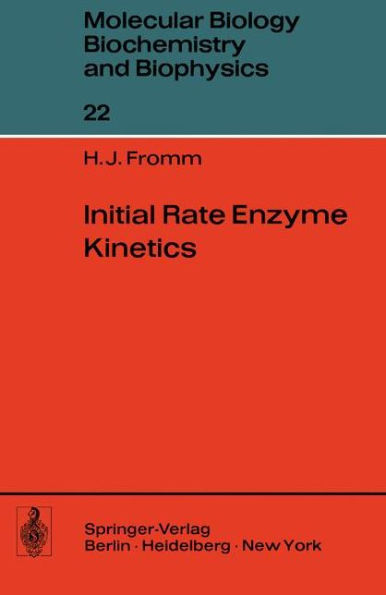Initial Rate Enzyme Kinetics
Enzyme kinetics has undergone very rapid growth and development during the past fifteen years and has been well received by the biochemical community. A cursory glance at the current biochemical literature reveals the increasing popularity of enzyme ki netics1 yet, there are very few books available to guide the enzymologist who wishes to conduct kinetic experiments. This monograph was undertaken to provide the fledgling kineticist with an outline of contemporary initial rate enzyme kinetics. A large portion of the material contained in this book is presented in a second-year, graduate-level course in biochemistry at Iowa State University. I have found that the presentation in this course has enabled students without a strong background in mathematics to undertake initial rate studies at the research bench. The monograph obviously is more comprehensive than any course could be, and should permit similar accomplishment. As the title implies, the major emphasis of this monograph is on initial rate enzyme kinetics. I considered at length the advis ability of including chapters on integrated rate equations and on the theory and application of rapid reaction kinetics, such as rapid-mixing stopped-flow, and temperature-jump kinetics. These, however, are topics that would require a good deal of space to develop if they were to be helpful to the beginner.
1012648989
Initial Rate Enzyme Kinetics
Enzyme kinetics has undergone very rapid growth and development during the past fifteen years and has been well received by the biochemical community. A cursory glance at the current biochemical literature reveals the increasing popularity of enzyme ki netics1 yet, there are very few books available to guide the enzymologist who wishes to conduct kinetic experiments. This monograph was undertaken to provide the fledgling kineticist with an outline of contemporary initial rate enzyme kinetics. A large portion of the material contained in this book is presented in a second-year, graduate-level course in biochemistry at Iowa State University. I have found that the presentation in this course has enabled students without a strong background in mathematics to undertake initial rate studies at the research bench. The monograph obviously is more comprehensive than any course could be, and should permit similar accomplishment. As the title implies, the major emphasis of this monograph is on initial rate enzyme kinetics. I considered at length the advis ability of including chapters on integrated rate equations and on the theory and application of rapid reaction kinetics, such as rapid-mixing stopped-flow, and temperature-jump kinetics. These, however, are topics that would require a good deal of space to develop if they were to be helpful to the beginner.
109.99
In Stock
5
1

Initial Rate Enzyme Kinetics
324
Initial Rate Enzyme Kinetics
324Paperback(Softcover reprint of the original 1st ed. 1975)
$109.99
109.99
In Stock

Product Details
| ISBN-13: | 9783642809682 |
|---|---|
| Publisher: | Springer Berlin Heidelberg |
| Publication date: | 01/28/2012 |
| Series: | Molecular Biology, Biochemistry and Biophysics Molekularbiologie, Biochemie und Biophysik , #22 |
| Edition description: | Softcover reprint of the original 1st ed. 1975 |
| Pages: | 324 |
| Product dimensions: | 6.69(w) x 9.61(h) x 0.03(d) |
From the B&N Reads Blog
